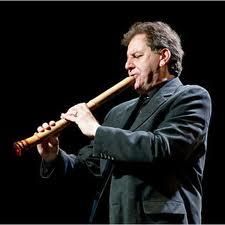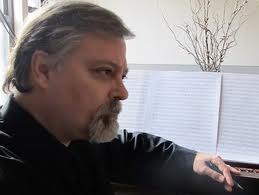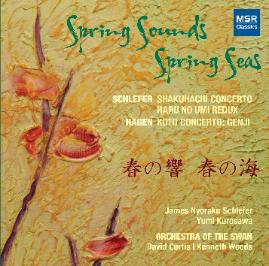James Nyoraku Schlefer’s Haru no Umi Redux is a distinctive version of the famous duo Haru no Umi by koto master Michiyo Miyagi a seminal work from 1929 that brought Western musical influences to Japanese instruments. In 1932, violinist Renee Chemet visited Japan on a concert tour and, after hearing Miyagi perform Haru no Umi, arranged the shakuhachi part for violin. She and Miyagi recorded the work and it became an immediate hit in both Japan and Europe. Haru no Umi is perhaps the finest example of the New Japanese Music movement of the 1920s, and was a rare and early success in the fusion of Western and Japanese musical elements. The opening phrases have become Japan’s musical theme for the New Year’s holiday. Haru no Umi Redux presents the work in its entirety and adds new material prior to both the opening section and its return. Mr. Schlefer’s original content suggests musical images of the sea.

Composer and shakuhachi virtuoso, James Schlefer
Schlefer’s Shakuhachi Concerto is a 3-movement work for shakuhachi, strings, harp and percussion, following classic concerto form. The shakuhachi is both soloist and team player, in concert or in conflict with the orchestra. The first movement opens with a brooding, somewhat unsettled section punctuated by irrepressible rhythmic utterances. The second movement begins with a cadenza followed by a cluster derived from the chords found in gagaku music. It then unfolds in a brocade of sound in the upper strings. With the exception of a brief intrusion of fast sunlight, the movement forswears a sense of pulse, allowing room for contemplation. The final movement is a Rondo in which restlessness competes with anxiety, and solo sections alternate between the violins and shakuhachi.

Composer Daron Hagen
Daron Hagen is well known as an opera composer, and not surprisingly his quite operatic Koto Concerto: Genji is based on the 11th century Tale of Genji. The eponymous character Genji is the son of a Japanese emperor, relegated to commoner status for political reasons. The complex story of his life unfolds during the course of the novel partly in the recounting of his relationships with women. The Concerto follows the seminal story of Genji falling in love with a woman without ever having seen her, but rather only after hearing her play the koto from afar for many years. The result is a concerto in five scenes, based on five psychological situations from the novel, with the conceit being that their love is consummated in the final moments. Kyo-Shin-An Arts’ commission to Mr. Hagen was his first venture writing for an instrument from a different musical tradition. He immersed himself in the repertoire and traditions of the koto, and combined what he refers to as the koto’s “magisterial past” with his own musical experience, using the life of this instrument to convey new ideas and emotions in the 21st century. The piece is scored for koto with single winds, two French horns, strings and marimba.
Kyo-Shin-An Arts is dedicated to integrating Japanese instruments specifically koto, shakuhachi and shamisen into Western classical music. Founded in 2008 with an initial purpose of commissioning established composers, KSA both presents concerts and partners with an international array of chamber ensembles and orchestras to perform the music. The intent is to bring forth the outstanding beauty of these instruments within the context of Western classical music, and build and promote a body of repertoire that does justice to the greatness and exactitude of these two classical traditions.



Recent Comments